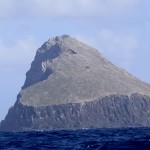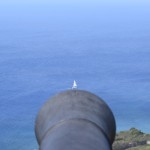It’s about 75 nm from Great Inagua to SW Acklins, which would definitely be an overnight sail. Or you can anchor midway. Midway of the passage resides a sudden shallow reef called Hogsty. The horseshoe-shaped reef barely cuts the oceans surface, so you should only spend the night when the seas are calm. We were fortunate enough to catch the passage at 11 knots and decided to go for it. We would anchor for the night completely surrounded by vastly deep ocean in every direction for 40 miles.
The safest way to enter the atoll is more of a westerly direction, too far South and you’ll be dodging large coral heads. With a shift in winds, we found the middle of Hogsty to have confused seas sloshing about but further to the NE where the seas consistently bubbled over the reefs, Gaia bobbed up and down peaceably at anchor. We dropped anchor in 13 feet of sand just east of the Liberty wreck, a freighter that went down in a 1963 hurricane. This is just one of 200 wrecks accounted for since the Columbus’ era of exploration.
We immediately brought the dinghy down and went on a snorkeling adventure. The water in the lee of this ship was murky with iron tainted waters but once we cleared the side, the water was clear and the shallow reefs stretched on and on luring you in to explore. I bravely snorkeled further from the ship peering around coral heads bobbing about and then … I saw IT! My first encounter with a shark and not a nurse shark. It was a reef shark with shark eyes and a shark snout in its shark environment. My first reaction was to reel around and swim as fast as I could to get Mike because Mike would surely protect me… but then I realized flailing around in the water to float next to another body would not eliminate the fact that I was still in the water with a shark. I decided to slowly float on over to Mike. By the time I had informed Mike, the shark was gone. So we continued swimming but I was less adventurous. We swam past the dinghy to the other side of the wreck and a barracuda kept unnervingly close tabs on us. Mike tapped my arm and pointed at another reef shark behind the barracuda. It wound its way around the coral heads, making its way closer to us before continuing on its rounds about the reef. Very conscientious of my heartbeat and limbs I was now a bit unnerved by the new territories of this water. A few minutes of poking about I watched a barracuda sprint away. I tapped Mike’s shoulder to show him. He tapped my shoulder and pointed in the opposite direction. My third reef shark was swimming ever-closer to both of us. That was it. That’s all I could take for one day. I hadn’t felt this defenseless since our crossing to Bermuda. I just wanted to be out of the water. I slowly watched the shark swim around and loop up right at us and I was acutely aware of how slow I was in the water as the sharks path came closer and closer. Mike was in front of me and began holding out the Hawaiian sling. Thank God, someone had something to stab at the shark. The shark came within 20 feet of Mike and deep inside I was freaking out thinking of all the worst case scenarios and how much all of them would … suck. But externally, I maintained a slow steady breath and kept my movements slow and minimal.
The shark eventually lost interest and we swam straight back to the dinghy. Once we were both out of the water, everything released. We both just began laughing in awe of swimming around sharks and how thankful we both were Mike decided to bring the spear. That was pretty darn cool.
We later learned shark advice from an adventure camera crew:
- Once you spot a shark don’t flail – the splashing is similar to that of a fish in distress and acts as a dinner bell to the shark. (check)
2. Don’t panic – maintain your normal breathing. When you jump in the ocean, sharks don’t smell you or hear you, they first feel the electrical pulses of your heart. (check)
3. For most sharks, you don’t look like their habitual meal. A majority of all shark attacks are because the shark mistook the human as food (fish) of some form. A sharks prey tend to dart to the surface. Maintain your buoyancy and try to maintain your lateral swimming position. (almost check)
4. Keep eye contact with the shark. If possible stare into its eye(s) and face the shark don’t turn your back to the shark. (2/3 check)
5. If the shark does dart at you…
a. give up the damn fish. Don’t fight the shark to keep whatever fish you’ve just speared.
b. punch the shark in the nose. (Yeah. About that…) The shark is most sensitive in the nose and, really, at the end of the day most to all sharks don’t want to be harmed and are weary of getting hurt.
The anchorage was amazing. It didn’t just feel like we were alone…. we really were alone and it was beautiful.
- entering Hogsty from the SW (too much to the S and you’ll be dodging coral heads)
- Outside of the atoll the water is thousands of feet deep
- inside the atoll is 13-20 feet deep
- Liberty ship
- we anchored just South
- Beautiful water
- Mike picked up a few conch
- and we made conch fritter out of this little critter













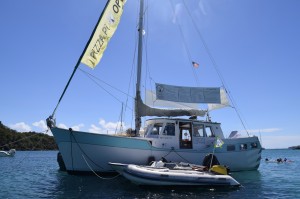


 But not so much that it took my mind off the fact that I was now 90 feet underwater and every inch of me was compressed by more than a few atmospheres. It’s a little alarming how long it takes your air bubbles to reach the surface at 90 feet. Feeling a little cold and recognizing I was approaching low air, we both slowly ascended on a mooring line – zero complications. No fire coral to report of.
But not so much that it took my mind off the fact that I was now 90 feet underwater and every inch of me was compressed by more than a few atmospheres. It’s a little alarming how long it takes your air bubbles to reach the surface at 90 feet. Feeling a little cold and recognizing I was approaching low air, we both slowly ascended on a mooring line – zero complications. No fire coral to report of.


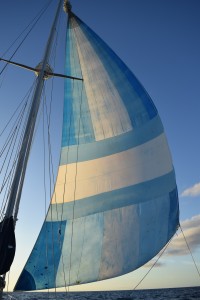

























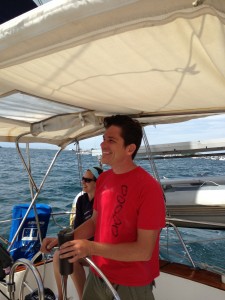



 butt of a boat). Gaia has a flat high transom with two flat latches that provide a “foot hold”. For all you climbers, it’s a V0 move. Dropping your feet onto a moving bouncing target can make grocery runs a little difficult. That said, grocery runs are a 4 part process, complete with balance, water, and squats. 1. Lock the boat climb into dinghy, dinghy to land and lock up dinghy. 2. Walk to the grocery store and grocery shop. 3. Carry groceries into dinghy, unlock dinghy, and dinghy back home. 4. Lift the groceries on deck, secure dinghy unlock the boat and put the food away. Big unsmiley face for dropping a grocery bag or having it tear while hoisting the bag on deck.
butt of a boat). Gaia has a flat high transom with two flat latches that provide a “foot hold”. For all you climbers, it’s a V0 move. Dropping your feet onto a moving bouncing target can make grocery runs a little difficult. That said, grocery runs are a 4 part process, complete with balance, water, and squats. 1. Lock the boat climb into dinghy, dinghy to land and lock up dinghy. 2. Walk to the grocery store and grocery shop. 3. Carry groceries into dinghy, unlock dinghy, and dinghy back home. 4. Lift the groceries on deck, secure dinghy unlock the boat and put the food away. Big unsmiley face for dropping a grocery bag or having it tear while hoisting the bag on deck. how much rice you put in your salt shaker, the salt always builds up and clumps due to the moisture in the air,
how much rice you put in your salt shaker, the salt always builds up and clumps due to the moisture in the air,


































